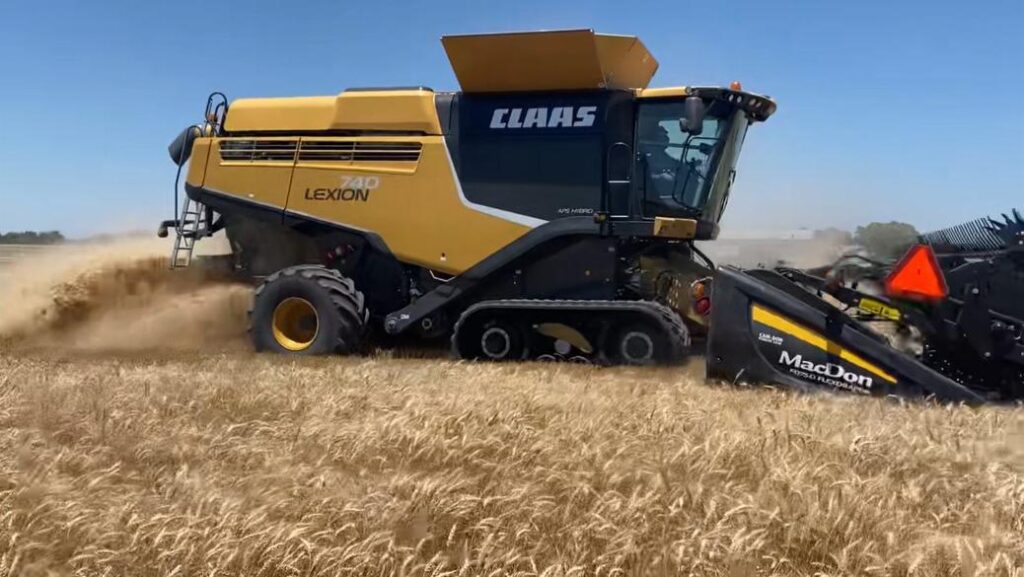Since harvest is the last pass over the field before planting, it is important to think about how to create the ideal seedbed.
Not only is there residue to manage, but harvest is when the heaviest equipment weights are rolling over your soil. Managing your traffic patterns when harvesting a field will pay off with reduced compaction. Grain cart operators need to understand preferred routes back to the truck. It is always tempting to cut across the field and take the shortest route. Combining a field starting furthest away from the truck leaves standing crop in the way so the grain cart must go along the ends. Wider equipment is better for less passes in the field, just be aware that overall axle weights can trump even a wide footprint. Just because the grain cart can hold 2,000 bushels and has less than 15 psi footprint does not mean surface compaction is being avoided.
Residue has become a popular topic as yields have increased and stalks are tougher to break down, there is more to deal with come planting time. Chopping corn heads seem to be the first thing growers turn to but chopping everything into little pieces just guarantees you will need row cleaners on the planter and the mat of residue will be slow to dry out further complicating the planting process. Chopping corn heads require more maintenance and power to run. Sure, a chopped corn field looks nice the first couple of days after finishing, but after the wind blows all fall and early spring that residue is no longer where you left it. Leaving the residue intact, ideally with even the husk still attached to the stalk and only the ear removed will allow sunlight to reach the soil and cutting large pieces of stalk is much easier for the planter. (See Dec 2013 newsletter) When you leave residue intact and don’t move or chop it, there is no worry about being able to spread the chaff coming out of the combine 40+ feet.
Most common solution for managing corn residue
- Chopping corn head = residue gets chopped into small pieces
- Requires more power, more maintenance of parts
- Row cleaners needed in spring to clear strip for openers
- Wind will blow residue into piles and ditches
- Mat of residue will seal off surface from sunlight
- Slow down stalk rolls/drive faster = Leaves stalks standing
- Less power needed, no extra parts
- Long stalks cut easily; row cleaners optional
- Stalks and leaves intact are anchored in one piece, will not blow away
- Cleaner grain sample when only the ears are pulled in
- Tall stalks catch more snow, retain moisture
The same principles apply to wheat and small grains. Stripper headers are necessary for a clean sample and faster/more efficient harvest. The moisture savings in stripper stubble will pass or fail the next crop in dry environments. Soybeans require combining the entire plant but running all that residue through the combine means getting an even spread out the back is critical. Removing the combines stationery chopping knives will leave soybean stems long. This will help spread those stems the full header width but also make it easier for the planter to cut through longer stems come spring.
Once mechanical fixes have been made to make residue less challenging, the next focus turns to a biological problem. There are valuable nutrients in the residue, and it is a biological process to make them available. Avoiding compaction as mentioned is just one of the steps to keep your biology cycling.
The Five Soil Care Principles go a long way to get your soils biology humming again. It’s amazing how quickly residue disappears when the cycle is undisturbed.
- Keep the soil covered
- Increase plant diversity/rotation
- Minimize soil disturbance
- Maintain live plant/roots
- Integrate livestock
There are quite a few biological products now that can be sprayed after harvest to accelerate breakdown. Test them for yourself and take some soil tests to see if there is a difference in available nutrients come planting time. We are still at the tip of iceberg to understanding exactly how nutrients and carbon are cycled for most efficient plant use. This will continue to be a growing topic as fertilizer prices stay high and we further our understanding of what’s happening underground. Doing a good job at harvest sets you up for a successful next season!

